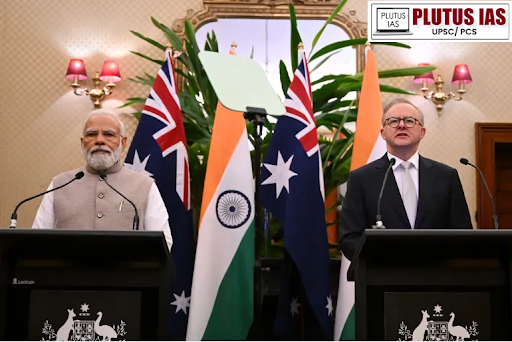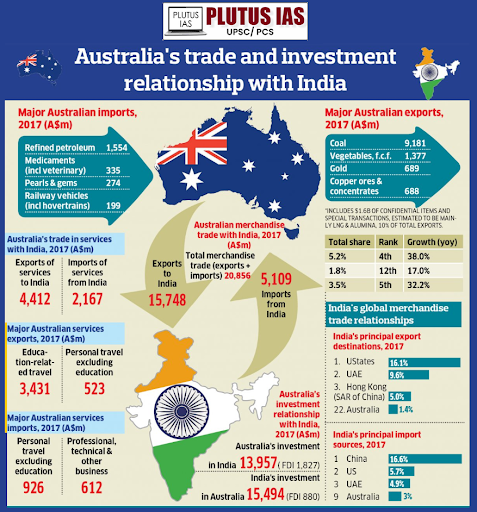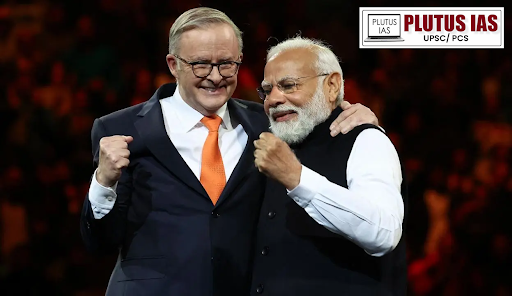23 Sep “Partners in Progress: The India-Australia Dynamic”
This article covers “Daily Current Affairs” and topic details of the “Partners in Progress: The India-Australia Dynamic”
Syllabus mapping:
GS-2: International Relations: India- Australia relationship.
For Prelims:
Key facts: Supply Chain Initiative, Quad, RCEP, Indo-Pacific Economic Framework for Prosperity (IPEF), ECTA free trade agreement. Malabar exercise and other bilateral exercises. Technology corporations.
For Mains:
What are the areas of the cooperation, the reasons for the increase in the cooperation in the recent period, and the significance of this cooperation for each other, what are the issues and future course of action to sustain bilateral relations?
Why in the News?
Shri Piyush Goyal to co-chair with Minister Farrell the 19th India-Australia Joint Ministerial Commission meeting in Adelaide.

India- Australia Bilateral Ties:
Historical Perspective:
The historical ties between India and Australia date back to the European settlement in Australia in 1788, when trade was largely managed by the British East India Company through Kolkata. Diplomatic relations began in the pre-independence era, highlighted by the establishment of the India Trade Office in Sydney in 1941. This marked the beginning of a formal engagement between the two nations, laying the groundwork for future collaboration. After India gained independence in 1947, formal diplomatic relations with Australia were established, reflecting shared values and interests. In 1950, India and Australia signed a Treaty of Friendship and Commerce, further solidifying their partnership.
The India-Australia Joint Ministerial Commission (JMC)
Establishment: The JMC was established in 1989.
Scope: Covers a range of topics related to trade, investment, and economic cooperation between India and Australia.
Significance: Serves as a platform for enhancing bilateral ties and addressing challenges in the economic relationship.
Pillars of Cooperation in India-Australia Bilateral Relations
Shared Democratic Values: Both countries are committed to pluralistic, Westminster-style democracies, which form the foundation for mutual respect and collaboration.
Economic Engagement: India is Australia’s sixth-largest trading partner, with bilateral trade surging from US$ 22.2 billion in 2021 to US$ 31.4 billion in 2022, a 41% increase. India’s exports to Australia rose by 38% to US$ 8.7 billion, while Australia’s exports to India grew by 42% to US$ 22.5 billion. The Economic Comprehensive Free Trade Agreement represents a significant milestone in their bilateral relations.
High-Level Interaction: Increasing diplomatic and political engagement at various levels enhances strategic cooperation and coordination on global issues.
People-to-People Ties: Approximately 3% of Australians have Indian heritage, with the Indian-born population being the second-largest overseas-born group. The Indian community plays an active role in various sectors, contributing to Australia’s dynamism and enterprise.
Cultural and Sporting Links: Shared interests in sports, particularly cricket and hockey, create a unique cultural bond and foster community engagement between the two nations.
Shared threat: India and Australia both are suffering the heat of China’s assertiveness and expansionism, so it is natural as per Kautilay’s logic enemy of the enemy are friends.
Defense cooperation: This extended from the joint exercises between both countries and logistics support in the Indo-Pacific. AUSINDEX, PITCH BLACK, Kakadu military exercises.
Resources & Energy Security: Both countries have a strong relationship in critical mineral explorations and other energy domains.
Plurilateral Cooperation: The QUAD, the IPEF, and Supply Chain Initiatives (SCI), are examples where both countries are actively engaging with each other.
Science and technology: The formal cooperation started in 1986, and now extends to many sectors including, AI, innovation, and other emerging technology.

Significance of Australia for India
Shared Democratic Values: Australia and India uphold common democratic principles, strengthening their partnership.
China Factor: Australia’s role is crucial in balancing China’s influence in the Indo-Pacific region.
Peace and Security: Both nations can collaborate to enhance peace and security in the Indo-Pacific.
Indian Ocean Cooperation: Joint efforts in the Indian Ocean promote stability and maritime security.
Economic Resources: Australia offers critical resources, including minerals and energy, essential for India’s growth.
Global Support: Australia supports India’s positions on various global issues, enhancing its international standing.
Role of the Diaspora: The Indian diaspora in Australia fosters stronger economic ties and investment in India.
Skill Development Programs: Collaborative skill development initiatives help enhance India’s workforce capabilities.
Counter-Terrorism Cooperation: Both countries work together to combat terrorism and enhance regional security.
Significance of India for Australia
Balancing China: India plays a crucial role in countering China’s influence in the Indo-Pacific region.
Diversifying Trade: Australia seeks to diversify its trade partnerships by strengthening ties with India.
Security Cooperation: Collaborative efforts in security address major regional challenges.
Minilateral Cooperation: Australia and India engage in minilateral arrangements to enhance strategic collaboration.
Large Market Potential: India represents a significant market for Australian goods and services.
Shared Democratic Values: Both nations uphold democratic principles, reinforcing their partnership.
Regional Stability: Cooperation with India contributes to peace and stability in the Indo-Pacific.
Climate Change Goals: Joint efforts in innovation and technology support climate change initiatives.
Challenges Impacting India-Australia Bilateral Ties
Untapped Trade Potential: There remains significant potential for expanding trade and commerce between the two countries.
Agricultural Trade Exclusions: Recent agreements exclude certain agricultural goods from free trade, hindering broader economic engagement.
Attacks on Indian Diaspora: Incidents of violence against the Indian community in Australia create diplomatic tensions.
Divergent Foreign Policy Goals: Differences in foreign policy priorities can complicate cooperation on various issues.
AUKUS Agreement: The AUKUS pact’s exclusion of India raises concerns about regional strategic dynamics.
Dependency on US-India Relations: Australia’s reliance on its partnership with the U.S. about India may limit independent engagement.
WTO Disputes: Conflicts at the World Trade Organization, including Australia’s opposition to India’s subsidies, strain economic relations.
Indian Ocean Competition: Leadership roles and competition in the Indian Ocean region can lead to strategic disagreements.
UNSC Reforms: Differences over reforms in the United Nations Security Council affect collaborative diplomatic efforts.
The Way Forward for Australia-India Relations

4Ds: Focus on the “4Ds” — democracy, defense, dosti (friendship), and the diaspora. This broader perspective can lead to deeper engagement across various sectors.
Enhance Multi-Sectoral Cooperation: Target key areas such as business, politics, media, education, and culture for collaboration.
Leverage the Diaspora’s Influence: Recognize and empower the Indian diaspora in Australia as vital contributors to strengthening bilateral ties.
Emphasize Common Values and Interests: Build on shared values, particularly in the Indo-Pacific region.
Critical areas: Identify collaborative opportunities in critical areas like water management, clean energy, counter-terrorism, and cybersecurity to drive mutual benefits.
Strengthen Trust Through Leadership Engagement: Continue high-level visits and dialogues between leaders to reinforce trust and mutual respect.
Climate change: Both countries share a border with the Indian ocean which is affected by climate change. Hence both countries can reduce and work well on the impact of climate change.
Science and technology: Both nations can cooperate in science and technology like the UK, Australia also can open its premier research institutes in India.
India Economic Strategy to 2035: This roadmap emphasizes India as a critical growth market for Australian businesses, advocating for deeper economic integration.
Conclusion:
The Australia-India relationship is evolving into a robust partnership built on trust and mutual understanding. This collaboration aims to enhance interactions among the Australian-Indian diaspora, business communities, youth, and leaders from both nations. As the significance of this relationship continues to grow, this forward-looking approach promises to unlock further opportunities for cooperation and economic growth, solidifying the ties between Australia and India for years to come.
Download plutus ias current affairs eng med 23rd Sep 2024
Prelims Question:
Q. India and Australia both are members of which of the following?
1. G20
2. Supply Chain Initiative
3. East Economic Forum
4. SAARC
5. Regional Comprehensive Economic Partnership.
Select the correct answer using the code given below:
A. Only two
B. Only three
C. Only four
D. All five.
ANSWER: A
Mains Question:
Recently India and Australia have inked the Australia-India Economic Cooperation and Trade Agreement (ECTA). In this light briefly discuss the features of such free trade agreements and what are its significance for India’s overall economic growth.
(250 words 15 marks)



No Comments